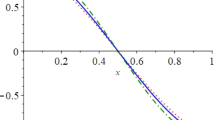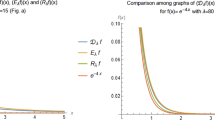Abstract
In this article we propose a locally adaptive strategy for estimating a function from its Exponential Radon Transform (ERT) data, without prior knowledge of the smoothness of functions that are to be estimated. We build a non-parametric kernel type estimator and show that for a class of functions comprising a wide Sobolev regularity scale, our proposed strategy follows the minimax optimal rate up to a \(\log {n}\) factor. We also show that there does not exist an optimal adaptive estimator on the Sobolev scale when the pointwise risk is used and in fact the rate achieved by the proposed estimator is the adaptive rate of convergence.
Similar content being viewed by others
References
Abhishek, A. (2022). Minimax optimal estimator in a stochastic inverse problem for exponential radon transform. Sankhya A. https://doi.org/10.1007/s13171-022-00285-4.
Butucea, C. (2000). The adaptive rate of convergence in a problem of pointwise density estimation. Statist. Probab. Lett. 47, 85–90.
Butucea, C. (2001). Exact adaptive pointwise estimation on Sobolev classes of densities. ESAIM Probab. Statist. 5, 1–31.
Butucea, C. and Tsybakov, A.B. (2007a). Sharp optimality in density deconvolution with dominating bias. I. Teor. Veroyatn. Primen. 52, 111–128.
Butucea, C. and Tsybakov, A.B. (2007b). Sharp optimality in density deconvolution with dominating bias. II. Teor. Veroyatn. Primen. 52, 336–349.
Cavalier, L. (1998). Asymptotically efficient estimation in a problem related to tomography. Math. Methods Statist. 7, 445–456.
Cavalier, L. (2001). On the problem of local adaptive estimation in tomography. Bernoulli 7, 63–78.
Cavalier, L. and Tsybakov, A. (2002). Sharp adaptation for inverse problems with random noise. Probab. Theory Related Fields 123, 323–354.
Cavalier, L., Golubev, Y., Lepski, O. and Tsybakov, A. (2003). Block thresholding and sharp adaptive estimation in severely ill-posed inverse problems. Teor. Veroyatnost. i Primenen. 48, 534–556.
Donoho, D.L. and Johnstone, I.M. (1994). Ideal spatial adaptation by wavelet shrinkage. Biometrika 81, 425–455.
Goldenshluger, A. (1999). On pointwise adaptive nonparametric deconvolution. Bernoulli 5, 907–925.
Goldenshluger, A., Juditsky, A., Tsybakov, A. and Zeevi, A. (2008a). Change-point estimation from indirect observations. II. Adaptation. Ann. Inst. Henri Poincaré Probab. Stat. 44, 819–836.
Goldenshluger, A., Juditsky, A., Tsybakov, A.B. and Zeevi, A. (2008b). Change-point estimation from indirect observations. I. Minimax complexity. Ann. Inst. Henri Poincaré Probab. Stat. 44, 787–818.
Hazou, I.A. and Solmon, D.C. (1989). Filtered-backprojection and the exponential Radon transform. J. Math. Anal. Appl. 141, 109–119.
Johnstone, I.M. and Silverman, B.W. (1990). Speed of estimation in positron emission tomography and related inverse problems. Ann. Statist. 18, 251–280.
Korostelëv, A.P. and Tsybakov, A.B. (1991). Optimal rates of convergence of estimators in a probabilistic setup of tomography problem. Probl. Inf. Transm. 27, 73–81.
Korostelëv, A.P. and Tsybakov, A.B. (1992). Asymptotically minimax image reconstruction problems. In Topics in Nonparametric Estimation, volume 12 of Adv. Soviet Math. Amer. Math. Soc., Providence, pp. 5–86.
Korostelëv, A.P. and Tsybakov, A.B. (1993). Minimax theory of image reconstruction, volume 82 of Lecture notes in statistics. Springer, New York.
Kuchment, P. (2014). The Radon transform and medical imaging, volume 85 of CBMS-NSF Regional Conference Series in Applied Mathematics. Society for Industrial and Applied Mathematics (SIAM), Philadelphia.
Lepski, O.V. and Spokoiny, V.G. (1997). Optimal pointwise adaptive methods in nonparametric estimation. Ann. Statist. 25, 2512–2546.
Lepski, O.V. and Willer, T. (2017). Lower bounds in the convolution structure density model. Bernoulli 23, 884–926.
Lepski, O.V. and Willer, T. (2019). Oracle inequalities and adaptive estimation in the convolution structure density model. Ann. Statist. 47, 233–287.
Lepski, O.V., Mammen, E. and Spokoiny, V.G. (1997). Optimal spatial adaptation to inhomogeneous smoothness: an approach based on kernel estimates with variable bandwidth selectors. Ann. Statist. 25, 929–947.
Lepskiı̆, O.V. (1990). A problem of adaptive estimation in Gaussian white noise. Teor. Veroyatnost. i Primenen. 35, 459–470.
Lepskiı̆, O.V. (1991). Asymptotically minimax adaptive estimation. I. Upper bounds. Optimally adaptive estimates. Teor. Veroyatnost. i Primenen. 36, 645–659.
Lepskiı̆, O.V. (1992). On problems of adaptive estimation in white Gaussian noise. In Topics in Nonparametric Estimation, volume 12 of Adv. Soviet Math. Amer. Math. Soc., Providence, pp. 87–106.
Lepskiı̆, O.V. and Spokoiny, V.G. (1995). Local adaptation to inhomogeneous smoothness: resolution level. Math. Methods Statist. 4, 239–258.
Monard, F., Nickl, R. and Paternain, G.P. (2019). Efficient nonparametric Bayesian inference for X-ray transforms. Ann. Statist. 47, 1113–1147.
Natterer, F. (2001). The mathematics of computerized tomography. Society for Industrial and Applied Mathematics.
Natterer, F. (1979). On the inversion of the attenuated Radon transform. Numer. Math. 32, 431–438.
Natterer, F. and Wübbeling, F. (2001). Mathematical methods in image reconstruction. SIAM Monographs on Mathematical Modeling and Computation. Society for Industrial and Applied Mathematics (SIAM), Philadelphia.
Quinto, E.T. (1980). The dependence of the generalized Radon transform on defining measures. Trans. Amer. Math. Soc. 257, 331–346.
Quinto, E.T. (1983). The invertibility of rotation invariant Radon transforms. J. Math. Anal. Appl. 91, 510–522.
Siltanen, S., Kolehmainen, V., rvenp, S.J., Kaipio, J.P., Koistinen, P., Lassas, M., Pirttil, J. and Somersalo, E. (2003). Statistical inversion for medical x-ray tomography with few radiographs: I. General theory. Phys. Med. Biol.48, 1437–1463.
Tretiak, O. and Metz, C. (1980). The exponential Radon transform. SIAM J. Appl. Math. 39, 341–354.
Tsybakov, A.B. (1998). Pointwise and sup-norm sharp adaptive estimation of functions on the Sobolev classes. Ann. Statist. 26, 2420–2469.
Tsybakov, A.B. (2009). Introduction to nonparametric estimation. Springer Series in Statistics. Springer, New York. Revised and extended from the 2004 French original, Translated by Vladimir Zaiats.
Vänskä, S., Lassas, M. and Siltanen, S. (2009). Statistical X-ray tomography using empirical Besov priors. Int. J. Tomogr. Stat. 11, 3–32.
Author information
Authors and Affiliations
Corresponding author
Additional information
Publisher’s Note
Springer Nature remains neutral with regard to jurisdictional claims in published maps and institutional affiliations.
Appendix
Appendix
Proof of Lemma 2.
(a) Let the distribution function for noise be given by \(p_{\epsilon }(u) = \frac {1}{\sqrt {2\pi \sigma ^{2}}} e^{\frac {-u^{2}}{2\sigma ^{2}}}\). For the proof of this part, first consider,
Recall that for \(f_{n,1} = Ah^{\beta _{1}-1} \eta ((x-x_{0})/h)\) where \(h = \left (\frac {\log n}{n}\right )^{\frac {1}{2\beta +1}}\), similar to equation (18) in Abhishek (2022) we have, \({\int \limits }_{Z} (T_{\mu }f_{n,1}(\theta _{i},s_{i}))^{2} ds d\theta \leq c_{8} h^{2\beta +1}\) where c8 is a constant that can be made as small as desired by choosing a small enough A. In particular, we will choose A such that \(\frac {6(\beta _{N}-\beta _{1})}{(2\beta _{1}+1 )(2\beta _{N}+1)}>c_{8}>0\). We remark here that in deriving the estimate for \({\int \limits }_{Z}(T_{\mu }f_{n,1}(\theta _{i},s_{i}))^{2} ds d\theta \) as above, we assume that the design points satisfy a certain feasibility condition (Korostelëv and Tsybakov 1991, Assumption C): \(E_{(\theta ,s)}\left [\sum \limits _{i=1}^{n}g(\theta _{i},s_{i})\right ] \leq C_{3} n\int \limits _{Z}g(\theta ,s)dsd \theta \). Thus
Proof of part (b) We want to show that \({\sigma _{n}^{2}} = {\sum }_{i=1}^{n}V_{1}[Z_{n,i}]\) is bounded below. First note that from the ‘law of total variance’ V1[Zn,i] ≥ E(𝜃,s) [V1|(𝜃,s)[Zn,i]]. Consider
Recall that noise has been assumed to have a Gaussian distribution \(\sim N(0,\sigma ^{2})\) Thus,
On the other hand,
Thus \(Var_{1|(\theta ,s)}[Z_{n,i}]=\frac {{4}(T_{\mu }f_{n,1}(\theta _{i},s_{i}))^{2}}{\log n\sigma ^{2}}\) and hence,
Proof of part (c)
Now we consider each of the above terms one by one. First of all \(E_{1}\lvert Z_{n,i}\rvert =E_{\theta ,s}[E_{1|(\theta ,s)}\lvert Z_{n,i}\rvert ] \). Thus using Pinsker’s second inequality to calculate:
Also note that since the cylinder Z = S1 × [− 1,1] has finite measure, we have:
From inequalities (A.3) and (A.4), we get:
Finally,
Using Eq. A.1, we have:
Then using the fact that \(\left \lvert T_{\mu } f_{n,1}(\theta _{i},s_{i})\right \rvert \leq c_{13} h^{\frac {\beta }{2\beta +1}} = c_{13} \left (\frac {\log n}{n}\right )^{\frac {\beta }{2\beta +1}}\),
Finally,
Now we consider \({\sum }_{i=1}^{n} E_{1}\lvert Z_{n,i}\rvert ^{3}\). For this we first evaluate:
where the last inequality follows from the previous one by integrating each term and using the fact that \(\lvert T_{\mu } f_{n,1} (\theta _{i}, s_{i}) \rvert \leq c_{13} \left (\frac {\log n}{n}\right )^{\frac {\beta }{2\beta +1}}\). Thus:
Rights and permissions
Springer Nature or its licensor holds exclusive rights to this article under a publishing agreement with the author(s) or other rightsholder(s); author self-archiving of the accepted manuscript version of this article is solely governed by the terms of such publishing agreement and applicable law.
About this article
Cite this article
Arya, S., Abhishek, A. Adaptive Estimation of a Function from its Exponential Radon Transform in Presence of Noise. Sankhya A 85, 1127–1155 (2023). https://doi.org/10.1007/s13171-022-00300-8
Received:
Accepted:
Published:
Issue Date:
DOI: https://doi.org/10.1007/s13171-022-00300-8




